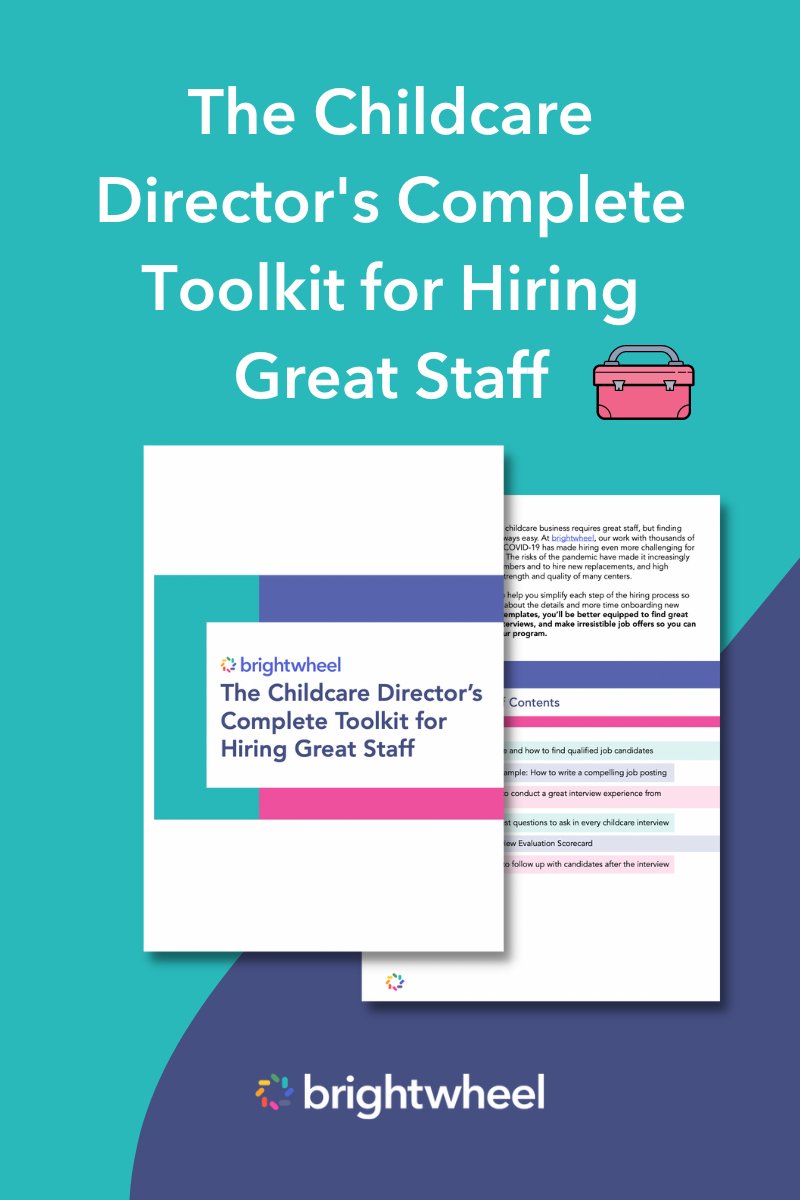
Finding and hiring quality childcare workers is a crucial aspect of running a successful childcare business. The caregivers and educators you choose to entrust with the well-being and development of children can make a significant impact on their growth and happiness. However, finding the right candidates for these positions can be challenging.
In this article, we will explore valuable tips and strategies to help you navigate the hiring process and attract top-notch childcare professionals.
Finding and attracting quality childcare staff
The individuals you choose to join your team will directly impact the well-being, development, and safety of the children under your care. Quality staff members possess a unique combination of skills, experience, and passion for nurturing and educating young minds. Here are some of the best ways to find and attract quality staff:
Create a comprehensive job description
Clearly outline the qualifications, responsibilities, and expectations for the position. Be specific about the necessary certifications, experience, and skills required. For example, mention if CPR and first aid certification are mandatory or if a degree in early childhood education is preferred.
Utilize multiple recruitment channels
To reach a wide pool of potential candidates, utilize multiple recruitment channels. Advertise the job opening on online job boards, professional networking sites, and social media platforms. Consider reaching out to local colleges and universities with early childhood education programs to connect with recent graduates.
Ask for personal referrals from teachers, employees, families, friends, and neighbors. Additionally, establish relationships with local childcare training institutions to tap into their candidate network. By diversifying your recruitment efforts, you increase your chances of attracting quality applicants.
Offer competitive compensation and benefits
Research the average salaries for similar positions in your area and ensure that your offer is fair and attractive. Consider providing additional benefits such as healthcare coverage, paid time off, professional development opportunities, and flexible work schedules. Offering enticing compensation and benefits demonstrates your commitment to valuing your employees' contributions and helps attract top talent.
Using a childcare management software like brightwheel at your center can be attractive to candidates. Two out of three teachers prefer to work at a program that uses brightwheel since it helps them easily communicate with families and saves hours per month on administrative tasks.
Highlight your workplace culture and values
In your job postings and interviews, emphasize your workplace culture and values. Share information about your organization's commitment to providing a nurturing and inclusive environment for both children and staff. Highlight any unique programs or initiatives you have in place, such as ongoing training and mentorship opportunities.
Candidates who align with your values and feel inspired by your organization's mission are more likely to be motivated and dedicated to their work, leading to better outcomes for the children in your care.
Offer opportunities for growth and advancement
Communicate your commitment to professional development and ongoing training during the hiring process. Outline potential career pathways and opportunities for advancement within your organization. This demonstrates that you value your employees' growth and are invested in their long-term success.
How to write a childcare worker job description
A well-crafted job description will save you time in the screening process and attract candidates who are genuinely interested and qualified for the role. It outlines the job's duties and responsibilities and lists the necessary skills, training, and education requirements that potential childcare workers must meet.
A thorough job description is necessary to advertise your job opening to potential applicants, but you can also use it during your interview, orientation, and job performance evaluation processes. Below is a step-by-step guide on how to write a childcare worker job description.
Step 1: Determine the job title
This is the formal title of the open position. Include any special requirements and level of experience in parentheses.
Step 2: Include a summary statement
The summary describes the position and the main responsibilities in two to three sentences. It also mentions who the childcare worker will report to.
Step 3: List job functions and responsibilities
This is often the most lengthy section of the job description, where you detail what the job entails and the duties the role will perform daily. List these in bullet point form in order of importance.
Step 4: Define the requirements
Outline the required skills and qualifications for the job. These can include education levels, years of experience, and specific certifications and licenses.
Step 5: Describe your mission, values, and benefits
This section is where you persuade potential candidates to apply to your vacant job position. Clearly describe your childcare center’s mission, values, and other benefits you offer your staff.
Interviewing the best childcare applicants
Interviewing is a crucial step in the childcare worker hiring process. When done right, you will be able to determine if the candidates’ skills, experience, and interests match your job opening. Here are tips to conduct fair and effective interviews:
Prepare a structured interview plan
Before conducting interviews, it's essential to have a structured interview plan in place. This ensures consistency and fairness throughout the process. Prepare a list of relevant questions that assess the candidate's experience, knowledge, and skills.
Consider including questions that focus on their understanding of child development, curriculum planning, behavior management techniques, and communication with families. By having a well-prepared interview plan, you can effectively evaluate each candidate and make informed hiring decisions.
Assess their experience working with children of different ages
When interviewing applicants for childcare positions, it's crucial to assess their experience working with children of different ages. Ask specific questions about their experience with infants, toddlers, or preschoolers, depending on the age group you are hiring for.
Request examples of activities, lesson plans, or strategies they have implemented to support children's developmental needs at various stages. This helps you gauge their ability to adapt and create engaging learning experiences tailored to different age groups.
Evaluate their understanding of safety and hygiene protocols
Inquire about the candidate's knowledge of safety and hygiene protocols, such as first aid and CPR certification, emergency procedures, and how they maintain a clean and sanitized environment. A strong emphasis on safety and hygiene demonstrates the candidate's commitment to maintaining a secure and healthy environment for children.
Gauge their ability to communicate effectively with families and colleagues
Assess the candidate's ability to communicate effectively with families and colleagues by asking them about their experience in collaborating with parents and discussing sensitive topics, such as child behavior or developmental concerns.
Look for candidates who demonstrate empathy, active listening skills, and the ability to establish positive relationships and open lines of communication. Their ability to foster strong partnerships with parents contributes to a supportive and collaborative learning environment.
Asses their understanding of inclusive practices and diverse needs
During the interview, ask candidates about their experience working with children from diverse backgrounds, including those with special needs or different cultural backgrounds.
Inquire about strategies they have used to create an inclusive and welcoming environment for all children. Look for candidates who demonstrate an understanding of the unique needs of each child and a commitment to fostering an inclusive and accepting atmosphere.
Use scenario-based questions to evaluate problem-solving skills
Present candidates with hypothetical situations that they might encounter in a childcare setting, such as handling a challenging behavior or managing conflicts between children.
Ask the candidate how they would approach these situations, what strategies they would implement, and how they would communicate with the children involved. Evaluating their problem-solving abilities helps you determine their capability to handle real-life challenges in a positive and constructive manner.
90-day onboarding checklist for childcare workers
After hiring staff for your childcare center, creating a well-structured and comprehensive onboarding process sets the stage for a smooth transition and helps new hires acclimate to their roles and responsibilities. An onboarding checklist saves you time and ensures you don’t leave out critical considerations during the onboarding process. Below we elaborate on why childcare staff onboarding is critical for your childcare business within the first 90 days:
- It helps managers organize important onboarding documents. Examples include fingerprint and background check forms, employee benefits application documents, policy and procedures files, child safety measures, and disaster management protocols.
- It prevents the early resignation of childcare workers. The onboarding process aligns expectations, preventing unnecessary misunderstandings between you and your employees. It also equips your new staff members with the necessary knowledge and tools to provide quality care.
- It helps employees determine how their purpose aligns with the company. Employees perform optimally when they understand how their skills, interests, and job responsibilities align with the company’s vision and contribute to the overall success of the business.
The childcare workers' 90-day onboarding process
Now that you know why the onboarding process is important for your childcare business's success, let’s dive into how to conduct the process in 90 days.
1. 0-30 days (first month)
The first month is the perfect time to introduce your new childcare staff to the company, its values, mission, strategies, and vision. It’s also an opportunity for your new employees to establish if their values align with yours. Studies reveal that sharing company values with new employees builds camaraderie and a shared interest in success.
Discuss expectations from both parties besides sharing your vision, mission, values, and strategies. Ensure your new employees understand their roles and your expectations. This way, you’ll prevent unnecessary misunderstandings along the way.
2. 30-60 days (second month)
The second month is a milestone for your new hires. They will be more comfortable with your childcare business goals, objectives, and other expectations. But you can still make them more effective by:
- Recognizing and rewarding good performance and talent publicly
- Brainstorming ways to improve areas of development
- Encouraging them to be proactive and contribute ideas at staff meetings
- Continuing to discuss expectations
3. 60-90 days (third month)
The third month is the peak of the onboarding process. Your new employees will be more confident, assertive, and fully aligned with their roles and expectations. The onboarding process at this time involves:
- Acknowledging and rewarding their proactivity, contributions, and commitment
- Offering solutions to matters arising within the childcare facility
- Providing additional training opportunities if necessary
Hiring childcare workers FAQs
1. How do I choose between two quality childcare worker candidates?
When deciding between two quality candidates, a thorough interview can move the needle. Ask all candidates the same questions to maintain a fair and insightful interview process. Listen to each candidate and gauge their experience and approach, then settle on the candidate with the best solutions.
2. What qualities should I look for in a childcare worker?
Look for childcare workers who possess qualities such as patience, empathy, adaptability, and strong communication skills. These traits are essential for building nurturing relationships with children and effectively collaborating with families and colleagues. A genuine passion for working with children, creativity, and the ability to problem-solve are also valuable qualities to seek in potential hires.
3. How important is experience when hiring childcare workers?
Experience is an important factor to consider when hiring childcare workers. Candidates with previous experience in a childcare setting may already have a solid understanding of child development, behavior management techniques, and age-appropriate activities.
However, it is also valuable to consider candidates who may have relevant transferable skills, such as teaching or counseling experience, as they can bring fresh perspectives and unique approaches to childcare.
4. How can I assess a candidate's ability to create a positive and enriching learning environment for children?
Ask candidates about their approach to curriculum planning, their understanding of child-centered learning, and their experience in implementing engaging activities. Request examples of previous lesson plans or projects they have developed and observe their enthusiasm for fostering curiosity, creativity, and a love for learning in children.
5. What strategies can I use to attract and retain quality childcare workers?
To attract and retain quality childcare workers, offer competitive compensation packages that include fair wages and benefits. Provide opportunities for professional development and advancement within your center. Foster a supportive and inclusive work environment where staff feel valued and appreciated.
Encourage open communication and feedback, and regularly recognize and celebrate the accomplishments of your childcare team. Implementing work-life balance initiatives and flexible scheduling options can also contribute to employee satisfaction and retention.
Conclusion
By investing time and effort into the hiring process, you are setting the stage for a successful and fulfilling childcare program. By attracting candidates through clear job descriptions, conducting thorough interviews, and implementing a comprehensive onboarding plan, you can ensure that you are building a team of dedicated professionals who will provide the highest standard of care for the children in your center.
Brightwheel is the complete solution for early education providers, enabling you to streamline your center’s operations and build a stand-out reputation. Brightwheel connects the most critical aspects of running your center—including sign in and out, parent communications, tuition billing, and licensing and compliance—in one easy-to-use tool, along with providing best-in-class customer support and coaching. Brightwheel is trusted by thousands of early education centers and millions of parents. Learn more at mybrightwheel.com.




